

Probiotiques : un milliard de bactéries / d'allégations douteusesLe Pharmachien. Les probiotiques, c’est pas des patentes-à-gosse holistiques : c’est de la médecine.

En effet, on a accumulé tellement de données scientifiques à leur sujet qu’on peut maintenant les utiliser intelligemment, avec une bonne efficacité, pour des problèmes de santé bien précis. Évidemment, on ne sait pas tout sur eux, mais les connaissances évoluent vite. Par contre, pour avoir une quelconque pertinence, ils doivent être utilisés pour les bonnes raisons. Mais ce que je rencontre le plus souvent à la pharmacie, c’est ce type de situation : Un virus contre le cancer. Il y a 60 ans, la poliomyélite. Un virus contre le cancer. 7 antiseptiques naturels. 8 antibiotiques naturels. Les antibiotiques Les antibiotiques sont une catégorie de médicament. Des champignons sous les ongles ? Bonne chance !Le Pharmachien.
Si tu as une infection à champignons sous les ongles, je n’ai qu’une seule chose à te dire : bonne chance.
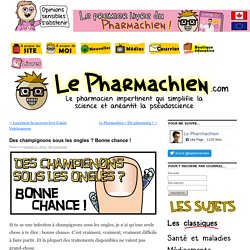
C’est vraiment, vraiment, vraiment difficile à faire partir. Et la plupart des traitements disponibles ne valent pas grand-chose. Heureusement, dans la plupart des cas, c’est banal et tu peux mener une vie heureuse malgré tout. Au pire, l’ongle est légèrement épaissi et décoloré… rien d’inquiétant. Par contre, dans certains cas, le problème devient assez important et un traitement est alors essentiel. Quand j’étais étudiant, j’ai travaillé quelques années comme préposé aux bénéficiaires dans un hôpital. Probiotiques : un milliard de bactéries / d'allégations douteusesLe Pharmachien. Herpes Virus Recruited To Fight Against Skin Cancer. The herpes simplex virus (HSV) is something no one ever wants to be infected with.
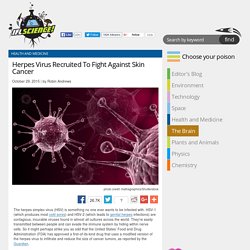
HSV-1 (which produces most cold sores) and HSV-2 (which leads to genital herpes infections) are contagious, incurable viruses found in almost all cultures across the world. They're easily transmitted between people and can evade the immune system by hiding within nerve cells. So it might perhaps strike you as odd that the United States’ Food and Drug Administration (FDA) has approved a first-of-its-kind drug that uses a modified version of the herpes virus to infiltrate and reduce the size of cancer tumors, as reported by the Guardian. Imlygic, an injectable drug made by Amgen Inc., will be used on cancerous tumors – in this case, malignant melanoma (skin cancer) tumors that cannot be surgically removed.
This drug will only be applied to patients with metastatic malignant melanomas, meaning that the cancer has begun to spread to other parts of the body, or “metastasize.” [H/T: The Guardian] Bionic Leaf Uses Bacteria To Convert Sunlight Into Fuel. Harvard researchers have announced a method to turn sunlight and air into isopropanol (C3H8O).

While mainly used as a solvent and in pharmaceuticals, isopropanol can also be used as a liquid fuel for transportation, or converted into even more convenient fuels. Plants have been transforming sunlight into things that we can use for fuel for 1.6 billion years. However, with a few exceptions, they are still only about 1% efficient. Solar cells do much better, but the energy produced must either be used immediately or stored in ways that can be problematic. To address this, researchers are trying to find ways to turn the energy generated from sunlight into fuels that are easy to store. Antibiotic Resistance Doesn’t Just Make Bacteria Harder To Kill – It Can Actually Make Them Stronger. Antibiotics are wonderful drugs for treating bacterial infections.
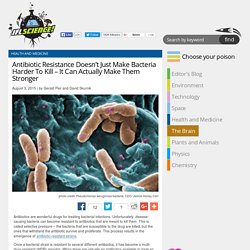
Unfortunately, disease-causing bacteria can become resistant to antibiotics that are meant to kill them. This is called selective pressure – the bacteria that are susceptible to the drug are killed, but the ones that withstand the antibiotic survive and proliferate. This process results in the emergence of antibiotic-resistant strains. Bacteria On Shoes Could Help Forensic Teams Catch Suspects. Prospective criminals should take note: bacteria are everywhere.
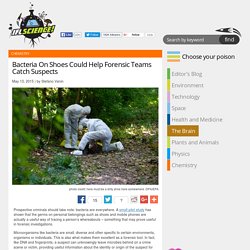
A small pilot study has shown that the germs on personal belongings such as shoes and mobile phones are actually a useful way of tracing a person’s whereabouts – something that may prove useful in forensic investigations. Microorganisms like bacteria are small, diverse and often specific to certain environments, organisms or individuals. This is also what makes them excellent as a forensic tool. In fact, like DNA and fingerprints, a suspect can unknowingly leave microbes behind on a crime scene or victim, providing useful information about the identity or origin of the suspect for forensic scientists. One day, such microbial signatures of individuals may prove as important as DNA or fingerprints, although a lot more research is needed to get there.
What Do The Bacteria Living In Your Gut Have To Do With Your Immune System? Your intestines are home to many different kinds of bacteria (and some non-bacterial organisms as well).
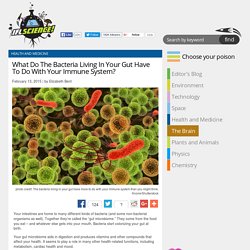
Together they’re called the “gut microbiome.” They come from the food you eat – and whatever else gets into your mouth. Bacteria start colonizing your gut at birth. Your gut microbiome aids in digestion and produces vitamins and other compounds that affect your health. It seems to play a role in many other health-related functions, including metabolism, cardiac health and mood. New evidence shows that the bacteria in our gut also interact with our immune systems, and might even influence the body’s immune reaction to vaccines. A Single Kiss Can Transfer 80 Million Bacteria. More than 100 trillion microbes live in our bodies, helping us digest food and stay healthy -- some 700 bacteria varieties live in our mouths alone.

Now, researchers show that up to 80 million bacteria can be shared during just one French kiss, and couples who kiss each other nine times a day or more share similar oral bacteria communities. The findings were published in Microbiome this week. Our microbiome is shaped by genetics, diet, age, and also those closest to us. "Intimate kissing involving full tongue contact and saliva exchange appears to be a courtship behavior unique to humans and is common in over 90 percent of known cultures,” says Remco Kort of TNO Microbiology and Systems Biology. “Interestingly, the current explanations for the function of intimate kissing in humans include an important role for the microbiota present in the oral cavity, although to our knowledge, the exact effects of intimate kissing on the oral microbiota have never been studied.”
Consommation d'antibiotiques et résistance des bactéries. 5 Diseases You Should Be More Afraid Of Than Ebola. The current outbreak of Ebola virus disease (EVD) in West Africa is the largest in history, and has already killed over 1200 people.

Those living in more developed areas have become fairly sheltered from the devastating effects of widespread infectious disease over the last 60 years or so, due to widespread availability of vaccines, competent healthcare, and education about hygiene’s role in disease transmission. Ebola is particularly unlikely to cause a pandemic in the developed world, as the method of transmission requires close contact with infected people. However, that doesn’t mean that it’s completely impossible for diseases to become widespread in more developed areas. Check out these 5 diseases that could easily cause a global health emergency: Influenza Around 3-5 million people around the world will become severely ill due to the flu virus every year, resulting in 250,000-300,000 deaths. Les bactéries, leur monde et nous. JanineGuespin-Michel Professeur émérite de microbiologie Les bactéries sont des organismes unicellulaires sans noyau, donc des procaryotes.
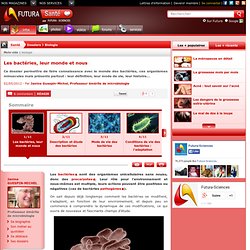
Du soleil et des bactéries pour fabriquer du carburant. Depuis des milliards d’années, des organismes vivants exploitent la photosynthèse pour fabriquer de la matière organique à partir de l’énergie du soleil. Ici, des cellules végétales (mousse de Plagiomnium affine) avec des chloroplastes visibles. Ces organites sont le siège de la photosynthèse. © Kristian Peters. Un virus géant, Mollivirus, renaît du sol gelé après… 30.000 ans. Mise en évidence des microorganismes en classe de Troisième. Mise en évidence des microorganismes, en les cultivant dans des boites de Pétri, au début du cours d’immunologie en Troisième : C’est le début de la partie sur l’immunologie en classe de 3°. Phagocytose 1. Mutations - sélection : les bactéries font de la résistance. Human Parasites. Watch White Blood Cells Attack A Nematode Larva. Take a look at a horde of white blood cells attacking a nematode larva.
It's a time-lapse shot over the course of 80 minutes as eosinophils (a type of white blood cell) migrate towards the roundworm and release digestive enzymes that break it down. And if you thought that was interesting, take a look at this white blood cell literally chase a Staphylococcus aureus bacterium through a field of red blood cells. David Rogers, Vanderbilt University The first clip comes from a 2014 study published in the Journal of Experimental Medicine. Check out this link for the orginal clip and more time-lapse videos of the immune system at work. Microbes On 8-Year-Old Boy’s Handprint After Playing Outside. Tasha Sturm, a lab technician at Cabrillo College in California, has created an extraordinary set of images that illustrate the diverse world of microbes that lives on our skin. This colorful petri dish is full of bacteria, yeast and fungi that were found on her 8-year-old son’s hand after he finished playing outside.
Sturm explained the process on Microbe World, where she posted the images. She used tryptic soy agar, which forms a nutritious jelly perfect for growing microbial cultures. After her son pressed his hand gently into the gel, she incubated it and let the bacteria flourish for a few days. Though the resulting petri dish should be treated as a biohazard, it should also be noted that having bacteria on your hands and skin is normal. The varying visible structures of these bacterial colonies reflect their microscopic characteristics. More info: microbeworld.org (h/t: colossal)